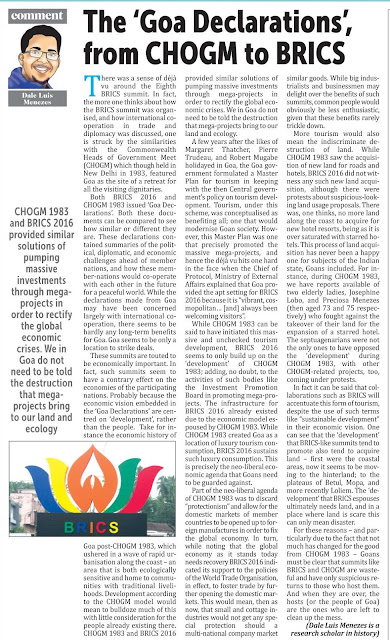There was a
sense of déjà vu around the Eighth
BRICS summit. In fact, the more one thinks about how the BRICS summit was
organized, and how international cooperation in trade and diplomacy was
discussed, one is struck by the similarities with the Commonwealth Heads of
Government Meet (CHOGM) which though held in New Delhi in 1983, featured Goa as
the site of a retreat for all the visiting dignitaries.
Both BRICS
2016 and CHOGM
1983 issued ‘Goa Declarations’. Both these documents can be compared to see
how similar or different they are. These declarations contained summaries of
the political, diplomatic, and economic challenges ahead of member nations, and
how these member-nations would cooperate with each other in the future for a
peaceful world. While the declarations made from Goa may have been concerned
largely with international cooperation, there seems to be hardly any long-term
benefits for Goa. Goa seems to be only a location to strike deals.
These summits
are touted to be economically important. In fact, such summits seem to have a
contrary effect on the economies of the participating nations. Probably because
the economic vision embedded in the ‘Goa Declarations’ are centered on
‘development’, rather than the people. Take
for instance the economic history of Goa post-CHOGM 1983, which ushered in a
wave of rapid urbanization along the coast – an area that is both ecologically
sensitive and home to communities with traditional livelihoods. Development
according to the CHOGM model would mean to bulldoze much of this with little
consideration for the people already existing there. CHOGM 1983 and BRICS 2016 provided
similar solutions of pumping massive investments through mega-projects in order
to rectify the global economic crises. We in Goa do not need to be told the
destruction that mega-projects bring to our land and ecology.
A few years
after the likes of Margaret Thatcher, Pierre Trudeau, and Robert Mugabe
holidayed in Goa, the Goa government formulated a Master Plan for tourism in
keeping with the then Central government’s policy on tourism development.
Tourism, under this scheme, was conceptualized as benefiting all; one that
would modernize Goan society. However this Master Plan was one that precisely
promoted the massive mega-projects, and hence the déjà vu hits one hard in the face when the Chief of Protocol,
Ministry of External Affairs explained that Goa provided the apt setting for
BRICS 2016 because it is “vibrant,
cosmopolitan… [and] always been welcoming visitors”.
While CHOGM 1983
can be said to have initiated this massive and unchecked tourism development,
BRICS 2016 seems to only build up on the ‘development’ of CHOGM 1983; adding,
no doubt, to the activities of such bodies like the Investment Promotion Board
in promoting mega-projects. The infrastructure for BRICS 2016 already existed
due to the economic model espoused by CHOGM 1983. While CHOGM 1983 created Goa
as a location of luxury tourism consumption, BRICS 2016 sustains such luxury
consumption. This is precisely the neo-liberal economic agenda that Goans need
to be guarded against.
Part of the neo-liberal
agenda of CHOGM 1983 was to discard “protectionism” and allow for the domestic
markets of member countries to be opened up to foreign manufactures in order to
fix the global economy. In turn, while
noting that the global economy as it stands today needs recovery BRICS 2016
indicated its support to the policies of the World Trade Organization, in
effect, to foster trade by further opening the domestic markets. This would
mean, then as now, that small
and cottage industries would not get any special protection should a
multi-national company market similar goods. While big industrialists and
businessmen may delight
over the benefits of such summits, common people would obviously be less
enthusiastic, given that these benefits rarely trickle down.
More tourism
would also mean the indiscriminate destruction of land. While CHOGM 1983 saw
the acquisition of new land for roads and hotels, BRICS 2016 did not witness
any such new land acquisition, although
there were protests about suspicious-looking land usage proposals. There
was, one thinks, no more land along the coast to acquire for new hotel resorts,
being as it is over saturated with starred hotels. This process of land
acquisition has never been a happy one for subjects of the Indian state, Goans
included. For instance, during CHOGM 1983, we
have reports available of two elderly ladies, Josephine Lobo, and Preciosa
Menezes (then aged 73 and 75 respectively) who fought against the takeover of
their land for the expansion of a starred hotel. The septuagenarians were not
the only ones to have opposed the ‘development’ during CHOGM 1983, with other
CHOGM-related projects, too, coming under protests.
In fact it can
be said that collaborations such as BRICS will accentuate this form of tourism,
despite the use of such terms like “sustainable development” in their economic
vision. One can see that the ‘development’ that BRICS-like summits tend to
promote also tend to acquire land – first were the coastal areas, now it seems
to be moving to the hinterland; to the plateaus of Betul, Mopa, and more
recently Loliem. The ‘development’ that BRICS espouses ultimately needs land,
and in a place where land is scare this can only mean disaster.
For
these reasons – and particularly due to the fact that not much has changed for
the good from CHOGM 1983 – Goans must be clear that summits like BRICS and
CHOGM are wasteful and have only suspicious returns to those who host them. And
when they are over, the hosts (or the people of Goa) are the ones who are left
to clean up the mess.
(First published in O Heraldo, dt: 9 November, 2016)

No comments:
Post a Comment